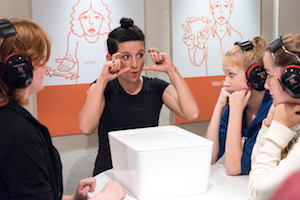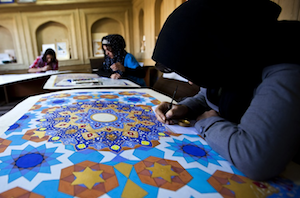Five Ways Museums Can Increase Empathy in the World
By Elif M. Gokcigdem
Museums are a safe place to explore other points of view, cultures, and histories.
 The Dialogue in Silence exhibitionCopyright: G2 Baraniak
The Dialogue in Silence exhibitionCopyright: G2 Baraniak
 Turquoise Mountain Exhibition
Turquoise Mountain Exhibition
 The Dialogue in Silence exhibitionCopyright: G2 Baraniak
The Dialogue in Silence exhibitionCopyright: G2 Baraniak
Museums are a safe place to explore other points of view, cultures, and histories.
This is not a particularly proud moment for humanity. Divisive narratives, poverty, inequality, injustice, famine, radicalism, war, and human rights violations thrive in countries around the world, while the natural world also suffers because of increasing human carelessness.
But what can we do? I believe we have many of the tools and technologies at our disposal to solve our problems; but they will not succeed until we adopt a worldview that values the collective well-being of the whole planet—all of humanity and the natural world that supports us. And that worldview takes empathy.
 The Dialogue in Silence exhibitionCopyright: G2 Baraniak
The Dialogue in Silence exhibitionCopyright: G2 Baraniak
Empathy is our inherent ability to perceive and share the feelings and thoughts of another. It allows us to connect with others who seem different, making us more aware of our commonalities. When we tune into empathy for others, we are more likely to act with compassion and altruism to help reduce their suffering. And, when we increase our caring for the environment, we are more likely to make choices that help preserve it for future generations.
Although empathy is a vital element of our nature, our civilization has not created the essential spaces, practices, and supporting ecosystems where it can be intentionally nurtured and unleashed towards the greater good. Yet research suggests that empathy can be taught, and that contact with people who are different from us in a safe, empathic way is a first step toward reducing prejudice.
This is where museums have a role to play. Museums are safe and informal learning platforms, uniquely equipped to encourage visitors to imagine, explore, and experience our rich human heritage and our natural world firsthand. They have the capability to bring together arts, technology, sciences, and literature to show how all living things are interconnected. They can also help fulfill an increasing demand for empathy in our lives, our workplaces, and our institutions.
My new book, Fostering Empathy Through Museums, showcases a variety of museums and programs currently fostering empathy through deliberate practices:
- Education and design aimed at raising awareness about people, places, and subjects of study outside of our normal experience;
- Experiential learning aimed at increasing emotional involvement with the subjects presented;
- Communicating and practicing empathy as an institutional core value, thereby role-modeling the importance of empathy in their institutional policies and practices.
Museums can be a fun and creative way to engage our empathy muscles and to inspire more empathy in our children, increasing our circle of caring beyond ourselves. Below are some of the ways that museums can be ideal places to foster more empathy.
1. Museums hold a mirror to society
 Turquoise Mountain Exhibition
Turquoise Mountain Exhibition
Through their social and educational mission, museums can provide a safe space for encountering our collective behavior, knowledge, complex histories, and values. By putting people in proximity to other people’s lived experiences, the artifacts from their cultures, and their stories, museums can help us awaken to different realities and multiple perspectives that exist around us.
For example, in the Turquoise Mountain Exhibition at the Smithsonian Institution’s Sackler Gallery, one can hear the stories of Afghani artisans making a living through the revitalization of traditional arts, meet the artisans, speak with them through a translator, observe them during their creative process, and touch and feel the ceramics, textiles, woodwork, and jewelry that they create. In this way, those of us who might not otherwise think about the plight of artisans and their families in war-torn, developing countries such as Afghanistan come to see and better understand their hopes, values, and struggles as similar to our own or to those of people we know.
Personal and multi-faceted encounters with people from other cultures—and their ideas, stories, and artifacts—create opportunities for authentic dialogue with “the other”: someone who is different from us, but shares our world. This serves to challenge any biases and stereotypes we may hold, while increasing our capacity for empathy.
2. Museums are a form of storytelling
Our brains are wired to retain information and make meaning in story format. Before writing was invented, our ancestors relied on storytelling to transfer critical, life-saving knowledge and wisdom and to help bond a community together. Modern research has shown that storytelling inspires empathy-building by allowing us to engage emotionally with the experiences of other people, even those with whom we may have little in common.
Museums often present the stories of people and places far away in place, time, or experience, in order to encourage empathy-building and more wide-ranging compassion. Telling stories from the point of view of the people and cultures featured can also increase our sense of shared humanity, as we see how others face fears, biases, and challenges similar to our own.
And because museum exhibits are strong in scholarship and research (and therefore can be a trusted source of information), through storytelling they can provide a learning experience that engages both hearts and minds.
3. Museums create experiential learning opportunities
 The Dialogue in Silence exhibitionCopyright: G2 Baraniak
The Dialogue in Silence exhibitionCopyright: G2 Baraniak
To increase empathy, it helps not only to provide knowledge and stories, but to create experiences that engage us in other ways. Research suggests that experiential learning is an effective way to increase learning in general, and empathy in particular.
Museums help us to experience empathy by offering interactive exhibits that encourage more than an intellectual understanding. For example, the “lunch counter” simulation experience at the Center for Civil and Human Rights in Atlanta leaves one with a firsthand understanding of what it was like to be in the shoes of a civil-rights protester in the ’60s enduring verbal and physical intimidation and racism while participating at a non-violent sit-in protest at a “whites-only” diner.
Here, visitors are invited to sit on a dining stool and put their hands on the lunch counter, where a sign ominously reads, “How long can you last?” A timer on the mirror behind the counter facing visitors monitors their endurance in seconds and minutes as the experience unfolds: direct verbal insults come through the headphones, as well as kicks and shoves that shake the dining stool. This simulation allows visitors—most of whom can only last a few minutes—to put themselves in the shoes of those civil rights protesters who had to endure these insults for hours.
Experiential learning sometimes requires a sense of vulnerability, as experienced through the Dialogue in the Dark or Dialogue in Silence exhibitions. Here, individuals who are blind, deaf, or mute become tour guides for visitors, who experience a perspective shift in the way they experience the world around them without a sense of sight, hearing, or speech.
We often learn better when we are engaged with all of our senses; so providing sensory-rich experiences—or, sometimes, strategically limiting our access to them to help us realize how much they shape our experience of the world—allows us to imagine different ways of being, which can help deepen the lessons of empathy imparted by museums.
4. Museums promote awe and wonder
How might one go about changing habitual and entrenched perspectives and behavior toward others? This usually requires more than just information; it requires some kind of paradigm shift, often caused by a transformative life event or some kind of deep learning.
For example, think of the “overview effect,” experienced by astronauts seeing our planet from outer space for the first time. This experience induces a strong sense of awe, connectedness to something greater than themselves, and compassion for the whole planet. Museums can also foster experiences of awe and wonder, through art, science, spectacle, beauty, and complexity.
Wonder often occurs around an extraordinary experience—something that is otherwise inaccessible to visitors in their daily lives. Extraordinary experiences should trigger two reactions: emotional and cognitive. The fleeting emotional reaction—the “Wow!” moment—is most effective if it is followed up by a cognitive reaction—the “How?” moment. In a museum setting where there are facilitators and docents available, the “How?” moment can take the form of further experimentation, dialogue, questioning, perspective taking, and reflection.
Since awe has been tied to a sense of oneness with others and altruism, a museum’s ability to foster awe can also help with the goal of increasing empathy and compassion.
5. Museums provide a safe space for contemplation
Museums encourage contemplation of our world by providing a space where we can slow down and be with what is before us, without needing to perform in any way. Unlike many everyday settings where the goal is clear, people are invited to explore in museums on their own schedule, moving from exhibit to exhibit as they see fit, following their own internal guidelines. This naturally allows for a more contemplative and reflective experience. Through this reflection, museum patrons can achieve a deeper understanding of the viewpoints of others and recognize their own connection to all of humanity and the planet.
At any given time and place, there are multiple ways of looking at and seeing a particular object, issue, or problem, as well as many ways that beings coexist and make sense of the universe. Museums that encourage us to understand, emotionally engage with, and contemplate this profound truth help us to become more responsive to the needs of those around us and of our environment. They help us gain a perspective-altering lens that awakens our sense of connectedness, respect, compassion, presence, and purpose. In this way, museums are uniquely positioned to help bridge the empathy gap so prominent in our world.